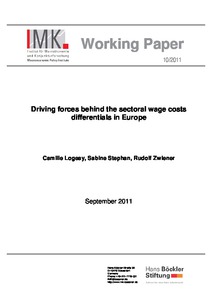Driving forces behind the sectoral wage costs differentials in Europe

Logeay, Camille ; Zwiener, Rudolf ; Stephan, Sabine
Hans-Böckler-Stiftung, Düsseldorf
HBS - Düsseldorf
2011
44 p.
comparison ; industrial sector ; labour cost ; statistics ; wage differential
IMK Working Paper
10
Wages and wage payment systems
English
Bibliogr.
"In 2004, Eurostat starts publishing new figures on hourly wage costs for all European countries. These figures are new in several respects: It is the first time that internationally comparable hourly figures on wage costs are available covering a quite important time period (1995-2005), so that not only cross-country comparisons but also dynamic analyzes are possible. Furthermore, these figures are fairly detailed at the sectoral level, therefore allowing for inter-sectoral comparisons. Concerning Germany, the Eurostat statistics provide quite unexpected insights; the gap between wage costs in the manufacturing sector and the (private and business) services sector is much larger than in other countries. This study aims at giving some explanations. According to theory, various explanations are possible. First, the neo-classical theory emphasizes factors affecting or indicating the level of individual productivity, as well as firm or sectoral productivity; indicators corresponding to this approach are tested. Second, dropping the assumption of perfect competition on both labor and goods markets allows for other factors (mark-up, market power) to influence the wage costs levels; these potential determinants are also tested. Finally, we think that the structure of demand (driven by domestic or foreign demand) could also have a major impact on wages in the industry and the services sector and indeed this factor seems to play an important role. This paper is structured as follows: First, the new Eurostat statistics is presented focussing on some interesting descriptive results. In the second section, we present a list of potential determinants of wage differentials between the industry and the services sector derived from theory and literature. A bivariate analysis (correlation) is then performed and conclusions are drawn. In a third step, a multivariate analysis (panel estimation) is performed. The final section concludes."
Digital
The ETUI is co-funded by the European Union. Views and opinions expressed are however those of the author(s) only and do not necessarily reflect those of the European Union or the ETUI.